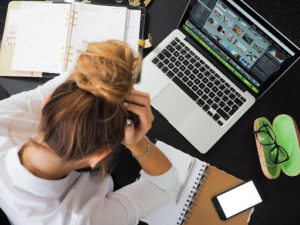Choosing the Best Posture Corrector
When it comes to posture, there is more at stake than just appearance and our vanity. Correct posture may outwardly signify confidence and poise to observers; however, what is happening internally with correct posture is just as important. Poor posture can be linked to back and neck pain and numerous other physical problems.
Despite knowing the importance of good posture, many of us struggle to maintain correct posture in our daily lives. As we hunch over our laptops for hours at a time, working toward a looming deadline, or when we collapse into a slump on the couch at the end of a long day, we often sit and stand in positions that are less than ideal for our backs, necks, and shoulders.
To force the daily habit of good posture, we have to train our muscles. Our bodies may have become so accustomed to bad posture that “good” posture feels strange or even strained at first. Working toward an appropriate alignment, where our bodies use energy efficiently and with stability, is one of the best things we can do for our overall health, especially as we age.
How Bad Posture Starts:

There is no one reason why we end up with bad posture; rather, it can occur as the result of a variety of reasons and daily habits. Some of it can come down to genetics and the way our bodies are shaped, and sometimes posture can be affected by injury or illness. For example, after a serious car accident, you may find it difficult to stand completely upright, if you have injured your back or neck.
Of course, the aforementioned “hunched over” work style is the enemy of back health everywhere. Those who work at desks and on computers for long periods are especially susceptible to poor posture. It takes an active commitment to sit upright and practice good posture to avoid strain on your back at work, and it can be easy to forget this habit when the stress of an important project is the primary focus of your mind.
Many people find that ergonomically designed work spaces help in this regard, with modern chairs and desk spaces constructed to ensure the best possible positions for your back and neck, and often to prevent injury to your wrists as well, with carpal tunnel syndrome being a potential hazard for those on computers all day. Fortunately, office furniture design now takes these issues into account and most new products on the market are as effective in ergonomic design as they are in style.
Beyond chairs and desks, though, there remains another incredibly useful tool that can help when it comes to preventing back pain: posture correctors.
What are Posture Correctors?
To help us practice good posture, posture correctors were designed as wearable devices that act as braces to keep the back and shoulders upright in an ideal position.
There are a few different varieties with different strap placements, and there are also some posture correctors specifically designed for women. In general, it is recommended they are worn for short periods (such as 30 minutes at a time) a few days per week.
The amount of time the brace should be worn will vary depending on the individual; if you have any concerns about wearing a posture corrector discuss these with your physician first.
Tips for Shopping for the Best Posture Corrector
If you want to give a posture corrector a try, to both improve your posture and alleviate back pain, keep these tips in mind as you shop:
Brace Softly: A brace can be helpful, but if too stiff it can also be harmful, causing muscles to atrophy. A good posture corrector should be soft and allow for muscles to be activated.
User-Friendly Placement: Make sure you can put the posture corrector on by yourself without any assistance.
Look for Target Areas: The best posture corrector will target the neck, lower back, and cervical thoracic junction.
Comfort is Key: A poorly constructed and uncomfortable posture corrector will become useless if the user cannot stand to wear it. A comfortable fit is of the utmost importance if you want the brace to be effective.
The Over / Under Factor: Some posture correctors can be worn under clothes, so if this is important to you—that it remains unseen—be sure to check the manufacturer’s information before purchasing.
The Best Posture Corrector
Gearari Posture Corrector for Men and Women
Material: Neoprene
Closure: Hook and Loop
The Gearari Posture Corrector is one of the easiest devices to use thanks to an adjustable, universal fit. This back brace can work with chests from 70 to 120 centimeters, thanks to adjustable straps and an easy Velcro closure.
It is invisible under clothing and can be worn comfortably by both men and women. Users note that they see improvements quickly after wearing the brace, with back pain minimized and an improved stance overall.
This product is ideal for anyone who may tend to hunch over a desk or sit or stand in otherwise unhealthy positions while working.
Putting this brace on is easy for anyone to do and the adjustable straps allow you to find the perfect, comfortable fit.
Material: Neoprene
Closure: Hook and Loop
If you are looking to improve posture but want to stay comfortable while doing it, look no further than a brace with “comfy” in its name! This posture corrector does the important work of aligning your frame to a healthy position but remains a soft and flexible device you can wear comfortably under your clothing.
The Comfy Brace Posture Corrector also gets high marks from us for its adjustability, fitting chest sizes from 30 to 43 inches. The manufacturer recommends starting out by wearing the brace in small increments (five to ten minutes daily) and then increasing over time.
The innovative, orthopedic design uses a breathable neoprene fabric that will not create excess heat or discomfort for users but remains durable and built to last. Users report seeing immediate benefits from wearing the brace for a short amount of time, with pain in the neck, shoulders, and back subsiding as posture improves.
The Comfy Brace Posture Corrector offers a great value for the price and is a fantastic tool to ward off back pain once and for all.
TUBNVOOT Back Brace Posture Corrector
Material: Neoprene
Closure: Hook and Loop
With a focus on full back support, the TUBNVOOT Posture Corrector comes in five different sizes to accommodate different body types. Based on weight, circumference, and height, the size choices are:
Small: waist 24-30 inches, height 5’4” and under
Medium: waist 30-35 inches, height 5’4” to 5’7”
Large: waist 35-39 inches, height 5’7” to 5’10”
Extra Large: waist 39-45 inches, 5’10” to 6’2”
Double Extra Large: waist 45-50 inches, height 6’2” and up
Some users find that narrowing down of the adjustment ranges makes the TUBNVOOT a better fit overall, and its breathable material makes it comfortable to wear over or under clothing. While it is lightweight and easy to use, it also makes a significant impact on posture and back pain.
Some users indicated the brace rides up around the waistband, but this can be corrected with some adjustments.
OK Goods Back Posture Corrector
Material: Cotton
Closure: Hook and Loop
One of the best features of the OK Goods Back Posture Corrector is how discreet it is: the brace is hardly noticeable at all under clothing. Even with this small profile, it is doing effective work to alleviate back and shoulder pain for users.
Slipping into this brace is as easy as slipping your arms into a backpack. The adjustable device can accommodate chest sizes from as small as 25 inches in diameter to as large as 53 inches. Additionally, this product comes with a link to an e-book to help consumers with back and shoulder pain exercises and tips.
Users report that wearing the OK Goods Back Posture Corrector for just a short time each day yields significant and immediate results.
Qcheye Store Back Brace Posture Corrector
Material: Polyester
Closure: Hook and loop
One of the more robust devices on our list, the Qcheye Store Back Brace Posture Corrector, targets the whole back effectively and is made of breathable materials and durable construction.
Three sizes are available to accommodate chest sizes under 35 inches in diameter (medium), 35-39 inches (large), and 39-45 inches (extra-large). Once you slip the brace on like a backpack, you can easily adjust the shoulder straps to find the perfect fit for correcting your posture.
Wearing the brace for a short time each day will help you develop muscle memory, promoting better posture at all times, and alleviating back, neck, and shoulder pain.
Tips for Using Your Posture Corrector
Once you purchase a posture corrector, make sure to do the following:
- Read all of the manufacturer’s instructions and follow them closely.
- Do not wear the brace all day! Most manufacturers recommend wearing them for no more than a few hours. Refer to the specific instructions included with your brace.
- Be sure to review the cleaning instructions; do not put the device in a washing machine unless recommended by the manufacturer.
- Adjust the straps as much as needed to find the ideal fit. If the straps are causing skin irritation they may need to be loosened.
- Never allow a child to use a brace unsupervised.
- Speak to your physician about using a posture corrector, especially if you have been given other medical braces for your back.
More Ways to Improve Your Posture
While posture correctors are a fantastic way to jump-start a new healthy posture habit, there are also other activities you can try to simultaneously improve posture and reduce pain.
Bear in mind that if your improved posture efforts are related to an accident or injury, you should always have a discussion with your physician before trying anything new, especially when it comes to exercise. Back injuries can be extremely serious, and the last thing a recovering patient needs is to exacerbate pain or prolong recovery.
If poor posture has resulted in back, neck, or shoulder pain and you are looking for relief, follow these easy tips to get started.
Sit with Pillows
Many of us love nothing more than to lounge on an oversized sofa after a long day, queuing up Netflix for a stress-relieving binge session. Relaxation does not have to mean posture goes by the wayside, though. Simply try to prop yourself up on a pillow when you are sitting on the couch or even in your favorite lounge chair. This will go a long way toward helping with your posture.
Make Posture Work at Work
Take a good look at your work setup, whether that means a home office or a corporate environment, and ensure your chair is adjusted to the optimal height for posture. If you cannot type comfortably while sitting up straight, you may want to consider a workstation that also allows you to stand (with a raised keyboard).
Another incredibly important thing to remember while working is the need for movement breaks. Try to move around for at least 10-15 minutes of every hour.
Get Plenty of Exercise
Generally, any form of exercise will help with posture. Stretching and strengthening exercises (such as those done in yoga classes) will help improve posture and reduce stiffness and pain. Even a short daily walk or run can go a long way toward better posture; just be sure to discuss any new exercise routine with your physician first.
Electronics and Posture

Cell phones and laptops are, unfortunately, another enemy of good posture. We tend to look down at them, rather than propping devices up in front of us to maintain good posture while we use them. If you adopt the habit of propping up your devices, rather than keeping your neck bent down for long periods, you will see another benefit as well—fewer neck wrinkles!




